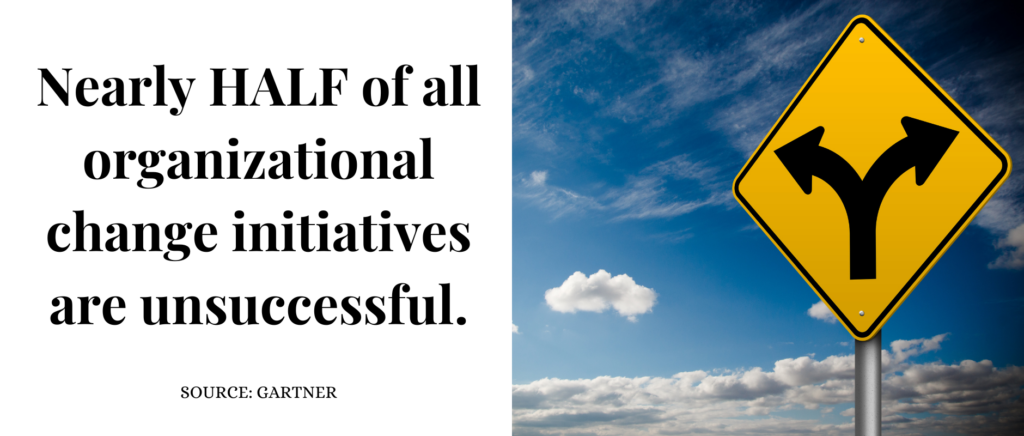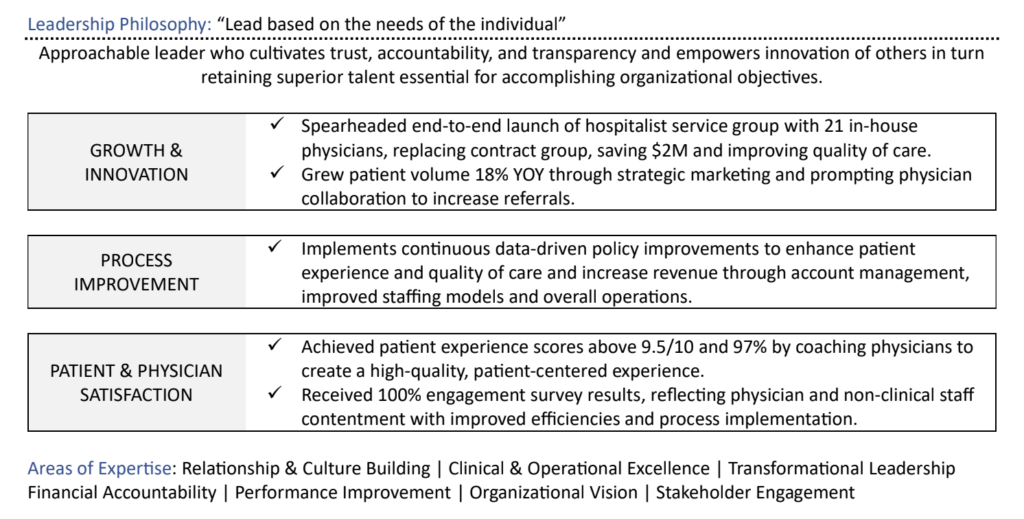
In the competitive realm of executive roles, your resume is the initial gateway to showcasing your qualifications and expertise. Among the various competencies and experiences, you may be tempted to include, highlighting specific leadership skills on your executive resume can significantly elevate your candidacy.
To stand out in the eyes of potential employers or executive search firms, you must take the time to create a compelling portrayal of your leadership prowess.
This article will delve into vital leadership skills that can enhance your executive resume.
Identifying Key Leadership Skills on the Executive Resume
When structuring an executive resume, it’s essential to pinpoint and emphasize leadership skills that align with the demands of high-level roles. Employers seek candidates who blend visionary leadership, strategic thinking, and the ability to navigate complexities while fostering a collaborative environment.
Identifying critical leadership skills for an executive resume involves a strategic approach that aligns with the demands of high-level positions. Before jotting down every skill you believe applicable for a role, thoroughly review the job description. It’s also worthwhile to examine job postings for executive roles similar to the one you’re targeting and pinpoint recurring leadership skills mentioned in these descriptions.
Look for terms like “visionary leadership,” “strategic planning,” and “change management,” as these keywords often signify crucial leadership competencies sought by employers. This article will further detail how to effectively use and include these leadership skills in your executive resume.
How To Showcase Visionary Leadership as a Skill on the Executive Resume
Masterclass defines visionary leadership as a forward-facing management style that inspires others to pursue a shared future. Visionary leaders do the following:
- Focus on a long-term plan for the future.
- Ideate a clear picture of the future.
- Communicate the plan to employees, fostering a community of collaboration and teamwork.

Remember, one of the most important jobs of a resume is to allow the reader to understand what qualities you have that match the needs of the role. Use specific bullet points to highlight these qualities and include precise, quantified results.
Here are some examples of how you can quantify and showcase your proficiency in visionary leadership:
- Demonstrate outcome-oriented statements: Rather than simply stating “possesses visionary leadership,” craft achievement-oriented statements highlighting specific instances where your visionary leadership made a difference. For example: “Formulated and executed a strategic expansion plan leading to a 25% revenue growth in new markets.”
- Quantify your achievements: Attach quantifiable metrics to your visionary initiatives whenever possible (for example: “Conceptualized and implemented a visionary marketing strategy that led to a 40% boost in customer engagement within six months”). Numbers and statistics provide concrete evidence of your impact.
- Consider including testimonials and recognition: If available, include testimonials or recognition from colleagues, superiors, or industry awards that acknowledge your visionary leadership. Quotes or awards add credibility to your claims. (For example: “Received CEO acknowledgment for visionary leadership in spearheading company-wide change.”)
Including Strategic Thinking as a Leadership Skill
Another critical executive resume skill is strategic thinking — a trait Harvard Business Review (HBR) describes as the ability to question the status quo, challenge one’s own and others’ assumptions and encourage divergent points of view. A professional with excellent strategic leadership first utilizes careful reflection and examination of a challenge through many lenses before taking decisive action. Furthermore, many modern companies aim to hire thoughtful, mission-driven employees and look at “the total package” beyond work experience.
Demonstrating strategic thinking on your executive resume underscores your capability to analyze complex situations, anticipate market trends, and devise long-term plans. Showcase your strategic leadership skills by outlining instances where your strategic decisions made a substantial impact. This could include cases in which you successfully restructured business operations to adapt to changing market dynamics or led a merger that significantly bolstered the company’s market position.
Here are some specific but compelling examples that include strategic leadership on the executive resume:
- Revenue growth and market expansion: “Led the development and implementation of a strategic market expansion plan, resulting in a 25% increase in market share and a $10 million revenue growth within two fiscal quarters.”
- Cost savings through strategic initiatives: “Formulated and executed a cost optimization strategy, resulting in a 15% reduction in operational expenses, generating annual savings of $5 million.”
- Strategic planning impact: “Directed strategic planning initiatives that contributed to a 30% improvement in operational efficiency, resulting in annual savings of $8 million.”
- Profitability enhancement: “Initiated and oversaw a strategic pricing restructuring that increased product profitability by 20% and drove a $15 million increase in annual gross margin.”
- Market penetration and growth: “Developed and executed a strategic market penetration plan that led to a 40% increase in new customer acquisition, generating an additional $12 million in annual revenue.”
- Successful product launches or innovations: “Spearheaded the strategic launch of innovative products resulting in a 50% increase in market share and a $20 million annual revenue boost.”
- Successful mergers or acquisitions: “Led the strategic integration process of a merger, resulting in a seamless transition and a 35% increase in overall company valuation within one year.”
- Efficiency improvements through strategic projects: “Implemented strategic process improvements resulting in a 25% reduction in project completion time, enhancing productivity and reducing operational costs by $3 million annually.”
Why and How To Include Change Management on the Executive Resume
In today’s ever-evolving business landscape, showcasing adaptability and adeptness in managing change is invaluable.
Harvard Business School Online references the skill’s importance, stating that businesses must constantly evolve and adapt to meet various challenges, from including changes in technology to the rise of new competitors to a shift in laws, regulations or underlying economic trends. The source also points to Gartner’s statistic that roughly 50% of all organizational change initiatives are unsuccessful — highlighting why knowing how to plan for, coordinate and carry out change is a valuable skill for managers and business leaders.

To effectively include this skill on your executive resume, share instances where you successfully led teams through transformative changes or adapted strategies to meet shifting market demands.
This could encompass scenarios where you orchestrated seamless transitions or implemented innovative changes that drove business growth. Here are some practical ways to include change management as a skill on an executive resume, along with examples:
Change initiative leadership: “Led a comprehensive change management initiative resulting in the successful integration of new technology, streamlining operations and reducing costs 15% within six months.”
Transformational change implementation: “Orchestrated and executed a cultural transformation program, fostering a more agile and innovative work environment, resulting in a 20% increase in employee engagement and productivity.”
Organizational restructuring success: “Directed and managed a company-wide restructuring effort, realigning departments and processes to adapt to market changes, resulting in a 30% improvement in operational efficiency.”
Mergers and acquisitions integration: “Guided the strategic integration process of two organizations post-merger, ensuring a seamless transition and cultural alignment, resulting in a 40% increase in market presence within the first year.”
Communication and stakeholder engagement: “Developed and implemented change communication strategies that effectively engaged stakeholders and mitigated resistance, leading to a smooth transition during a major organizational change.”
Training and development initiatives: “Designed and executed change management training programs for staff, ensuring a smooth adoption of new processes and technologies, resulting in a 25% reduction in onboarding time for new systems.”
Risk mitigation and problem-solving: “Identified potential risks during change initiatives and developed proactive mitigation plans, resulting in a 20% reduction in project delays and cost overruns.”
Continuous improvement and adaptability: “Championed a culture of continuous improvement, fostering adaptability to change and innovation, resulting in a 15% increase in operational flexibility and responsiveness.”
By incorporating points like this into your resume, you will highlight your proficiency in leading successful change initiatives, managing transitions, fostering a culture of adaptability and effectively addressing challenges associated with change.

The Importance of Key Leadership Skills on Your Executive Resume
Crafting a compelling executive resume requires more than just listing skills; it’s about painting a vivid picture of your capabilities. By highlighting specific leadership skills, such as visionary leadership, strategic thinking and change management, you’re showcasing your expertise and providing tangible evidence of your impact.
Your executive resume is a testament to your ability to drive growth, navigate complexities and steer organizations toward success.
Remember, each skill you include should be supported by concrete examples and quantifiable achievements, enabling potential employers to envision the transformative value you bring to the table. Tailoring your resume to showcase these leadership skills effectively positions you as an invaluable asset in the competitive landscape of executive roles.
